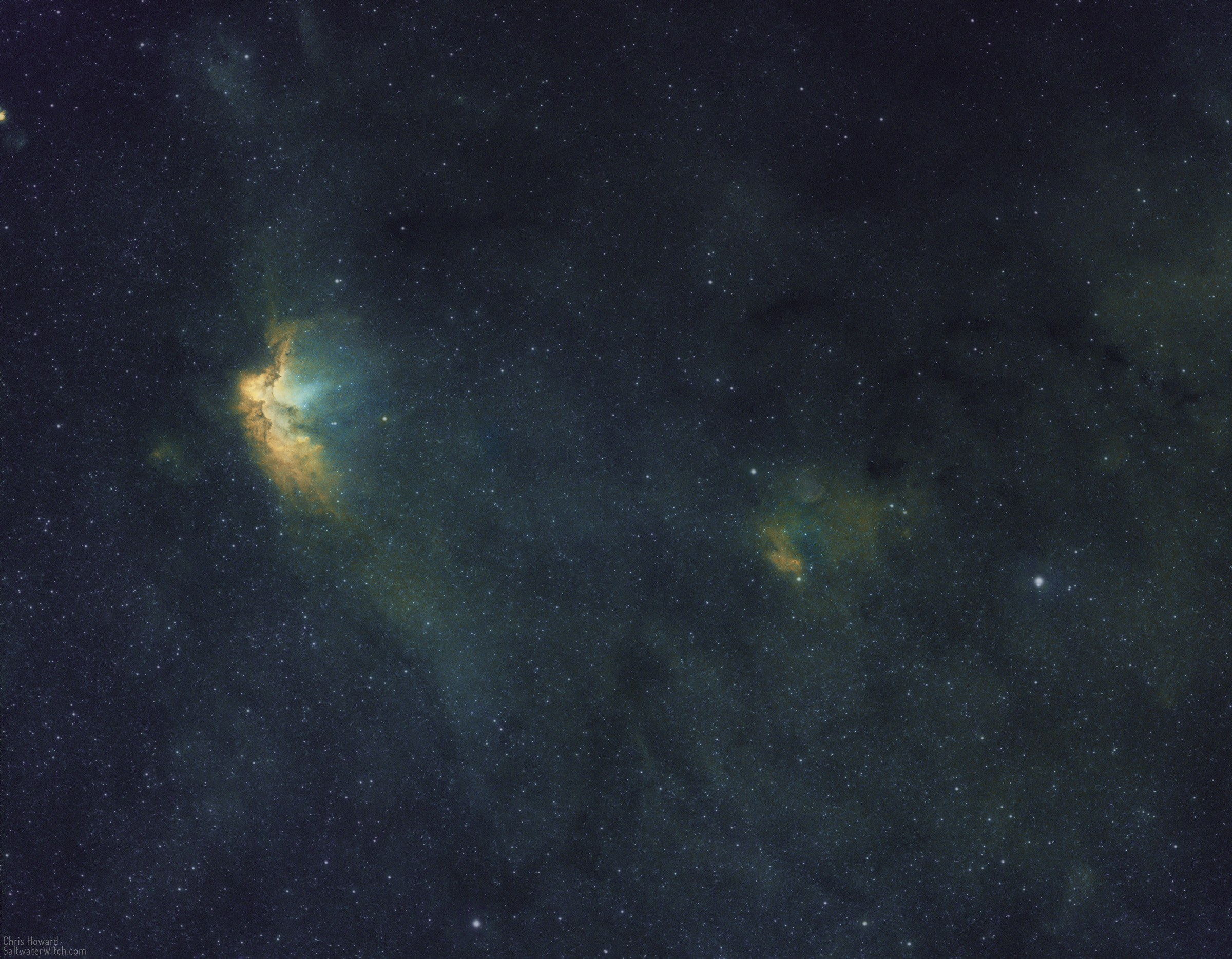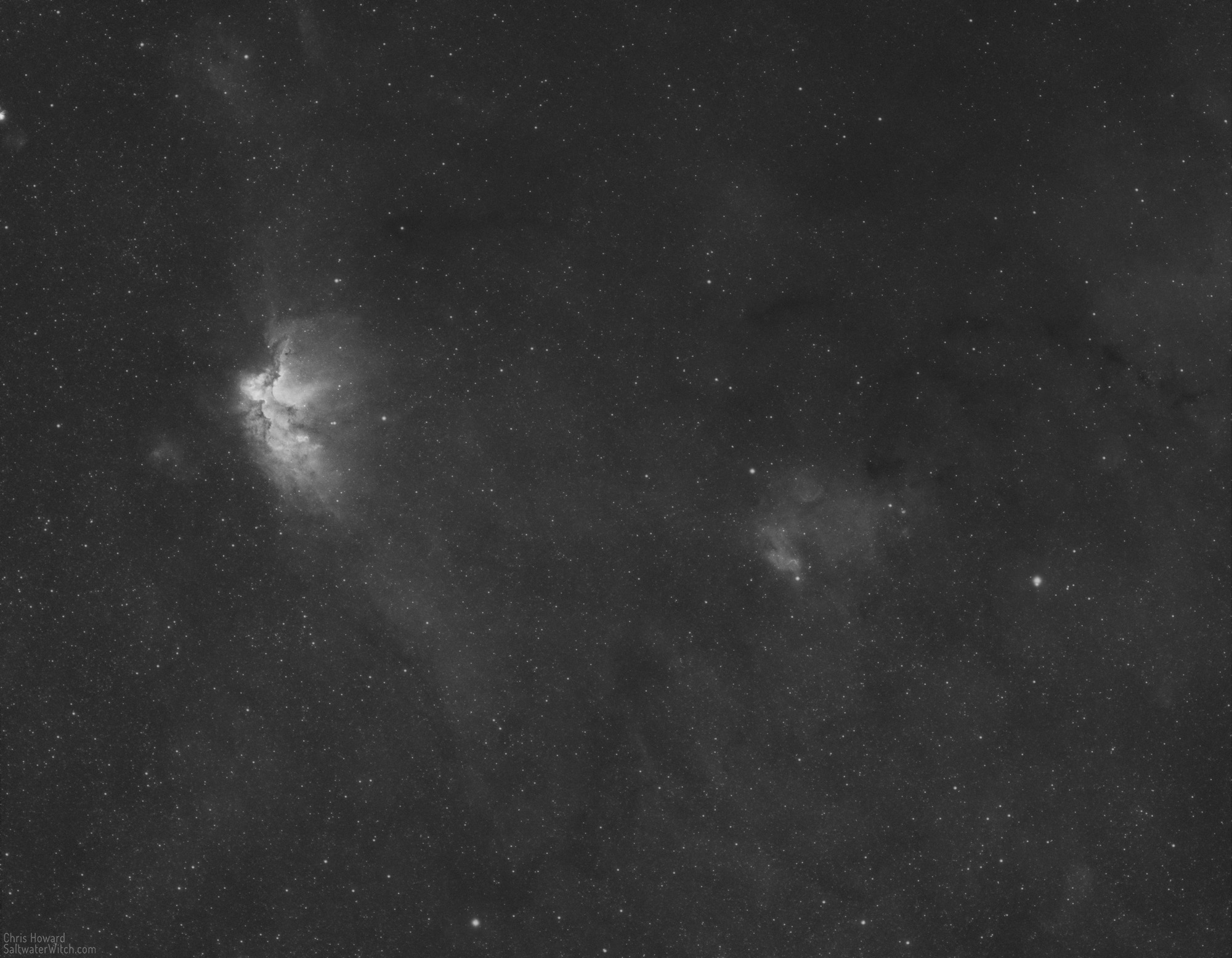Pretty good for an 80% moon
From last night’s narrowband imaging run: IC 1396 is a bright HII region over 2000 lightyears away in Cepheus, illuminated and ionized by the very energetic multi-star system HD 206267 (that’s the brightest star in the center of the image). The massive star, top left-ish, is a red supergiant, “the Garnet Star”, μ Cephei (mu Cephei). Mu Cephei is almost 100,000 times brighter than our star, the Sun, and it's over a 1000 times larger. Imaging notes: 61 x 300-second exposures stacked in PixInsight, camera: ZWO ASI2600MM-Pro cooled to -10C, Antlia 3nm Hydrogen-alpha filter. Even with an 80% waning moon, last night turned out well.
Posted October 3, 2023
NGC 7822 in Ha + OIII
Playing around with pixelmath in PixInsight with my narrowband data of NGC 7822, Cederblad 214, an emission nebula in Cepheus, about 3,000 lightyears away. This is Hydrogen-alpha (Ha) combined with Oxygen 3 (OIII) data I captured over several weeks, made up of 52 x 300-second exposures of Ha and 32 x 600-second (10 minute) exposures of OIII. Gear notes: William Optics Space Cat 51 (250mm FL @ f/4.9), ZWO ASI2600MM-Pro monochrome camera cooled to -10C, Sky-Watcher EQ6-R Pro mount, William Optics 32mm/120mm FL guide scope + ZWO ASI290MM-Mini guide camera.
Target Notes: NGC 7822, Cederblad 214, SH2-171 (the brighter emission nebula core) as well as the star cluster Berkeley 59. There are several long chains and clumps of dark nebulae, including LDN 1268, 1275, Dob 3637, 3627, 3623, many more. Nestled in that large band of dark nebulae toward the bottom is the reflection nebula GN 23.56.1. The very small circle of gray at the top left, blending in but dimmer than the nearby stars, with less contrast, is the planetary nebula Abell 1 (PLN 119+6.1). Find all of this—the nebulae and star forming complex in Cepheus near the edge of Cassiopeia.
Posted September 20, 2023
Off to shoot the Wizard
NGC 7380 is an open star cluster in Cepheus, surrounded by the bright emission nebula Sharpless 142 (Sh2-142, center, left), but we all know it as the Wizard Nebula. Why? Well, because it sort of looks like a bent old dude with a pointy hat looking out over a vast expanse of nebulosity, loops of dark interstellar dust, and a spread of hot stars bathing everything in intense radiation, all of which could be mistaken for some sort of magical display. In other words, what a wizard might do. That's my guess, anyway.
Last night was also my first night out with the ZWO ASIAir Plus (astro device controller), and because the Wizard has all three bands present to some degree, hydrogen-alpha, oxygen 3, and sulfur 2, I thought I would try something new: shooting 10 subs for each filter, running autofocus for each set, and then looping through each set of three filters three times. This way I would end up with 30 sub frames for each over the course of one night, a reasonable amount of data. This would also allow me to see how the meridian flip went, how well the autofocus routines work, and more. Note: with the 3nm Antlia Pro narrowband filters, each autofocus run takes about 7 minutes, with a set of 20 second exposures—the routine needs at least 20 just get enough stars to focus with these very narrow 3 nanometer filters.
It was also a cool mid-September night and with wind gusts and "poor seeing" according to the Clear Sky Chart, the guiding with the ZWO AM5 wasn't outstanding, but good enough for 300-second exposures, never straying too far above an arcsecond.
Here's the combined narrowband result in SHO, the Hubble Palette, where Sulfur is mapped to Red, Hydrogen to Green, and Oxygen to Blue in RGB colorspace.
Here's the Hydrogen-alpha data by itself:
Posted September 16, 2022
The Wizard
The Wizard Nebula in Cepheus surrounds the star cluster, NGC7380, discovered by Caroline Herschel in 1787. The Wizard is between 7000 and 8000 lightyears away from us, and the core star forming region is about 100 lightyears across. Notes: Shot from my backyard with a William Optics GT81, iOptron CEM25P EQ mount, Moonlite Focuser, ZWO ASI1600MM-Pro Monochrome Camera, Astronomik 6nm narrowband filters.

Posted April 25, 2020
The Wizard and the Soul
I captured almost 5.5 hours of OIII and SII data on NGC 7380 (Sh2-142) the Wizard Nebula and star cluster in Cepheus, along with a full set of narrowband frames for IC 1848 the Soul Nebula in Cassiopeia. I timed things well enough that I captured 20 subs each of Ha, OIII, and SII for the Soul before the earth rotated into early morning. Not a ton of data, but enough to process and see how it looks--not bad, in my opinion. My camera rotation is almost 90º off, almost vertical against the long side of the sensor, but I cropped the nebula to a square so you don't have to see how silly that looks.
I captured the Ha data for the Wizard Nebula early in July, and now I have enough to process in SHO (Hubble Palette) that's where we map the three bandpasses, sulfur (SII), hydrogen (Ha), and oxygen (OIII) to RGB, Red, Green, Blue to make up a color image.
Here's NGC 7380, Sharpless 2-142, Wizard Nebula:
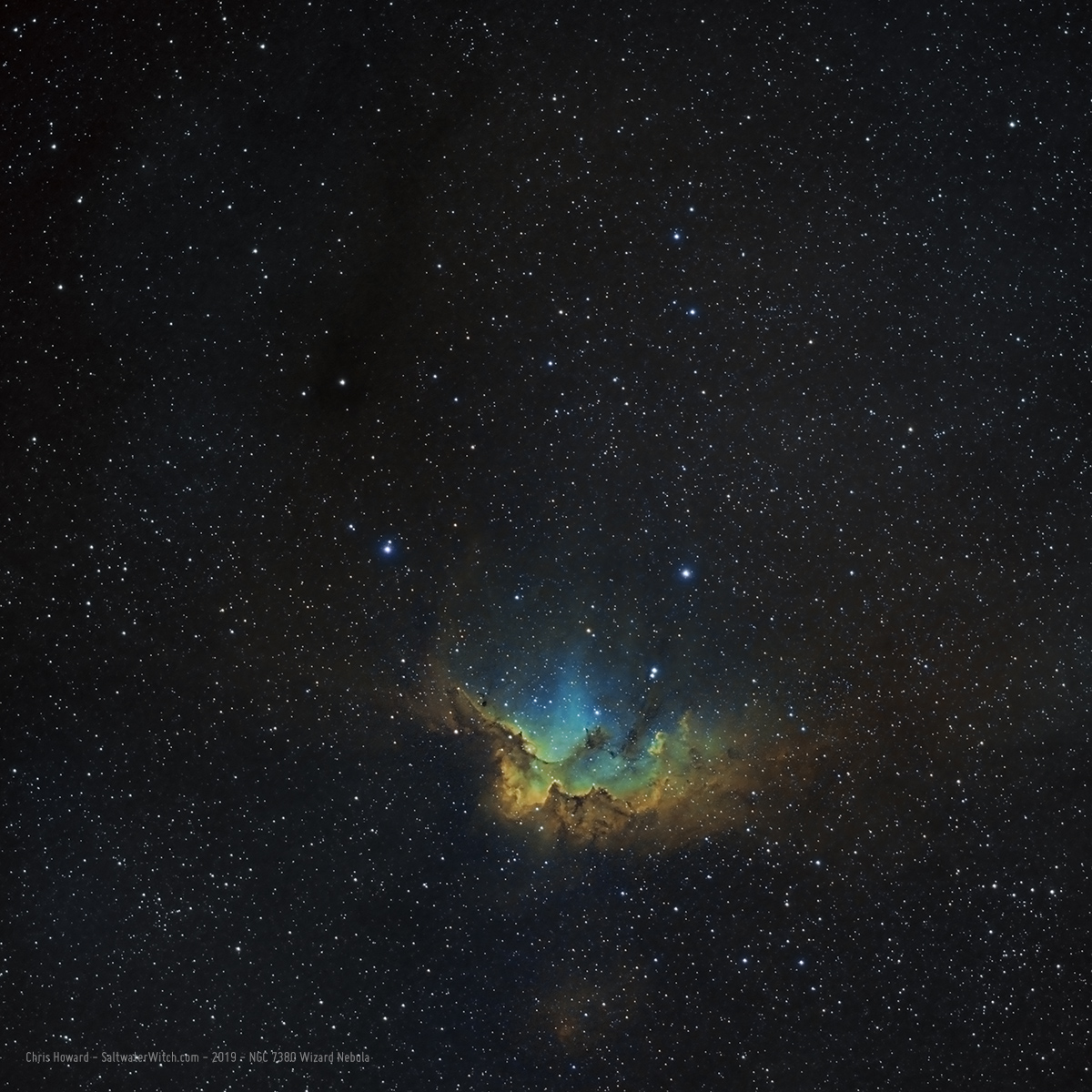
IC 1848, the Soul Nebula:
I don't know if I succeeded but I was trying to get more hydrogen green back into the arrangement. Most of the nebula is hydrogen--just going off the signal in the Ha frames compared with the OIII and SII data. The rims of both regions of IC 1848 are thick with sulfur--red and green gets us that golden brown, but I think the processes, filters, actions typical for astro imaging go too far in reducing green in the images, bending it more toward blue. This does have the benefit of bringing out oxygen, which is nowhere near as plentiful as the blues I see in most SHO/Hubble Palette images. That's just what everyone's come to expect from a "Hubble" image. On the other hand this is one of the coolest aspects of the hobby, the ability to go back and re-processes your data, because you have new or improved processing tools or skills, a new set of data, or simply because you want to experiment with color allocation.
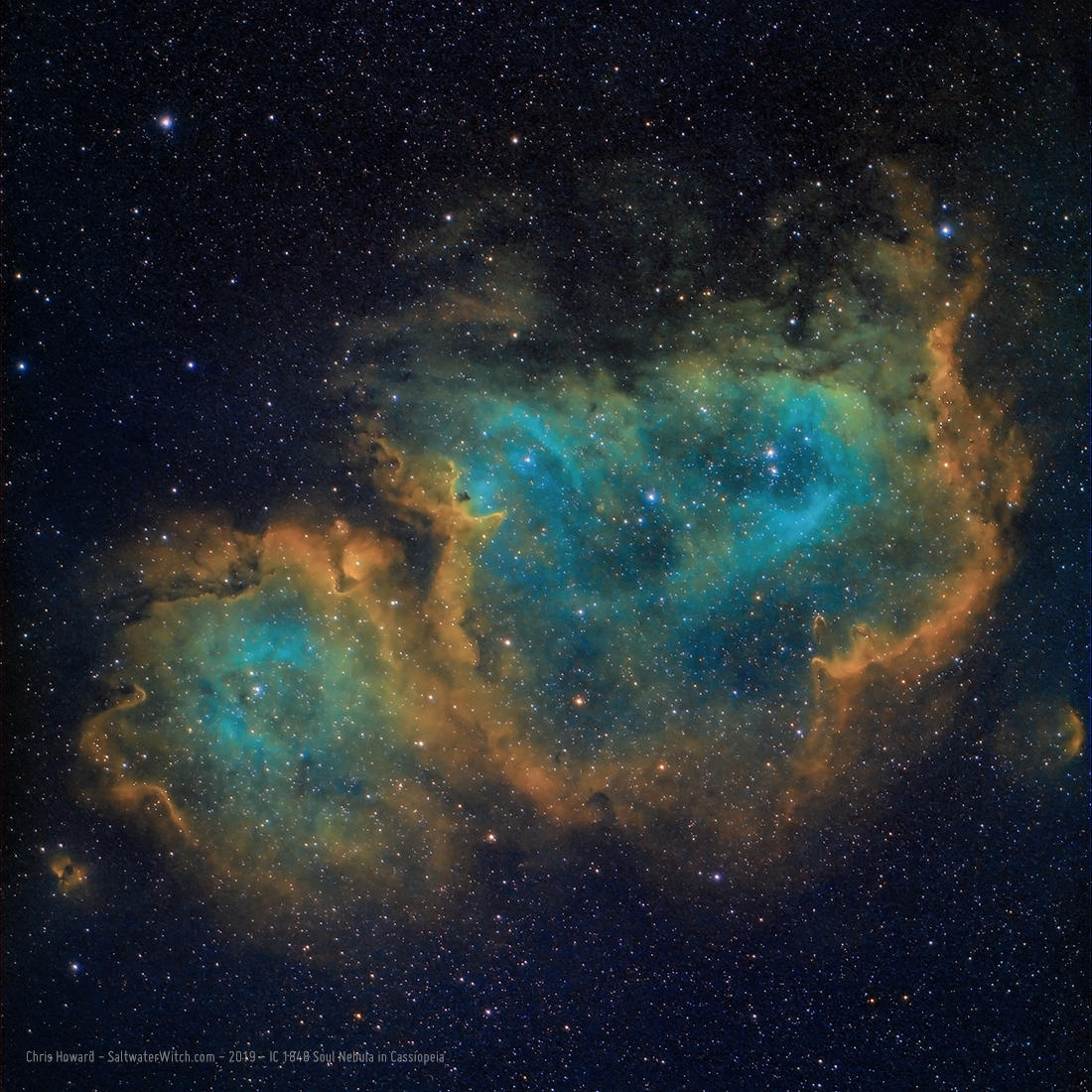
I woke up around 3:30 am and went out to check on the night's imaging run. I was in the middle of the sulfur2 frames when I took this shot with the Nikon: the William Optics GT81 APO refractor pointed at Cassiopeia (top left), actually just below it, which is where you will find IC 1848, the Soul Nebula. Just so you are aware, this is all automated--slewing, plate solving, focusing, filter rotation, and image capture. Once I plot and schedule an imaging run, the last place I want to be is near the telescope where the slightest motion in the ground can ruin a good 5-minute exposure. I was just out there to look at the beautiful sky, and take some crappy blurry photos of my astro gear against the starry background.
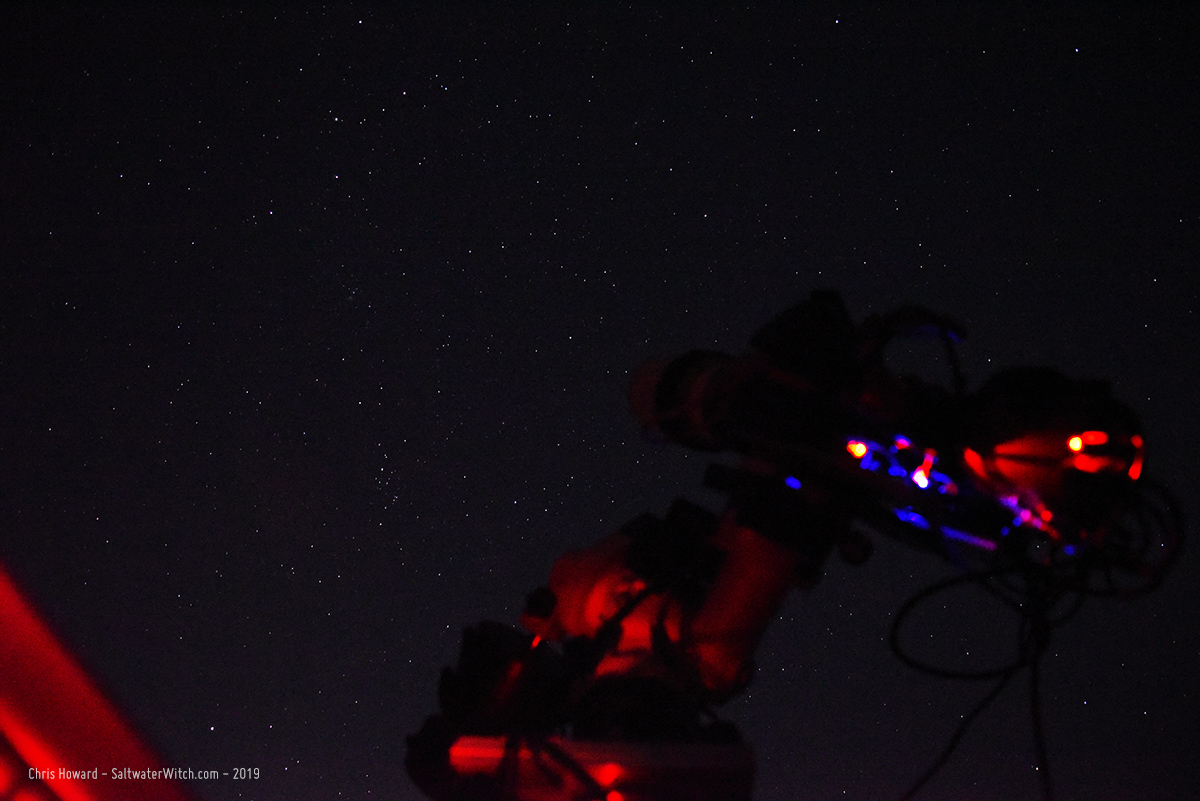
Posted August 2, 2019
Elephant Trunk Nebula
I hung around Cepheus and shot several hours of sub-exposures last night, mostly focused on IC 1396, the "Elephant Trunk Nebula", which is easy to make out near the center of the frame. This giant ionized gas region in Cepheus has some amazing dark bands of dust and other interstellar debris, blocking the light of more distant stars. Like there's that little guy on the right I want to call the "Harry Potter casts an Imperio" nebula. Imaging notes: bi-color made up of 48 stacked subs in Ha and OIII, William Optics GT81 APO refractor, ZWO ASI1600MM-Pro mono camera, Astronomik filters, iOptron CEM25P mount.
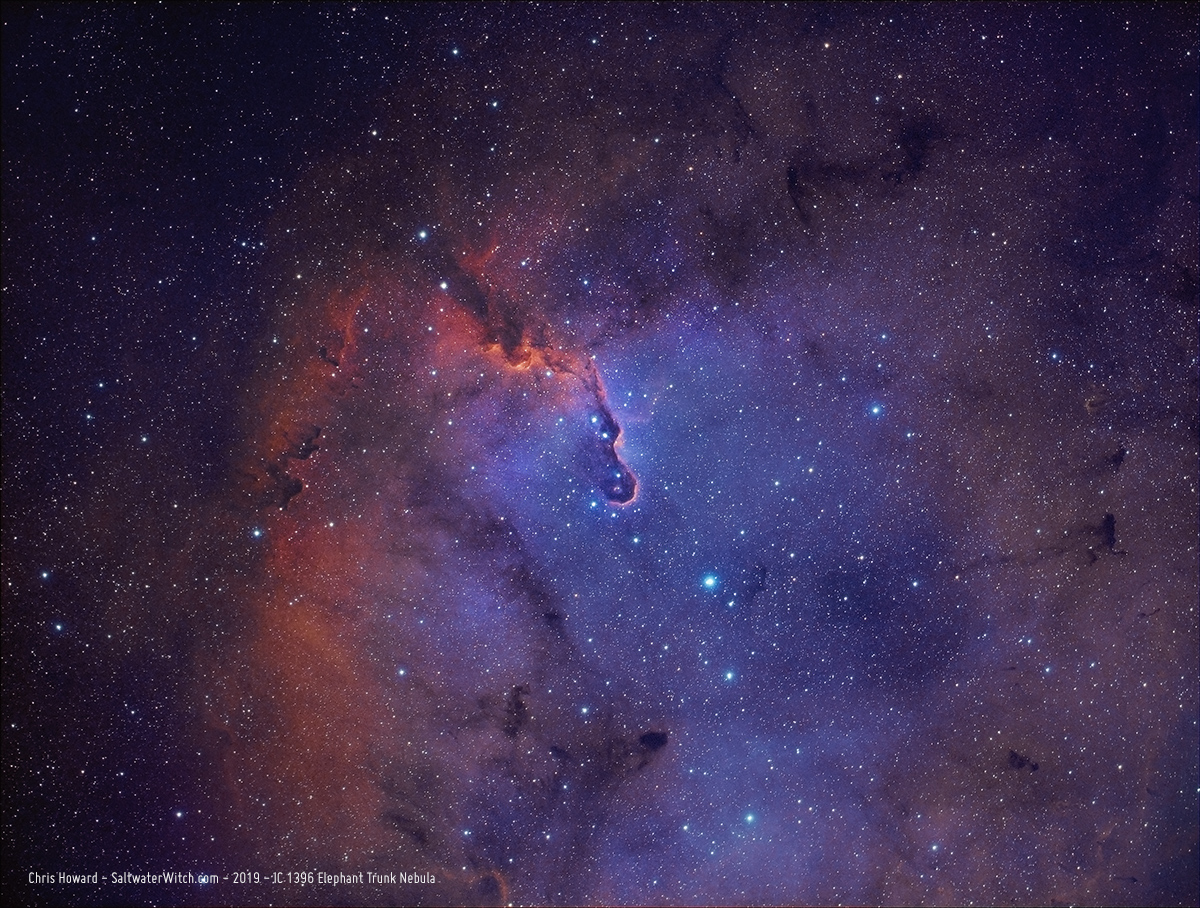

I also shot RGB subs. Here's the HaRBG:



